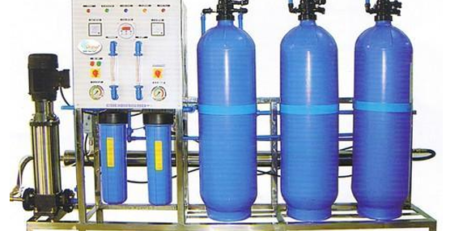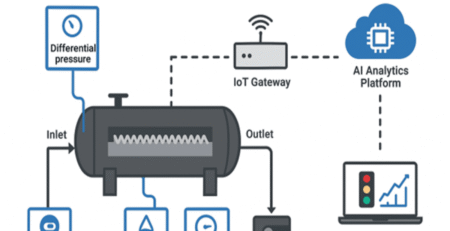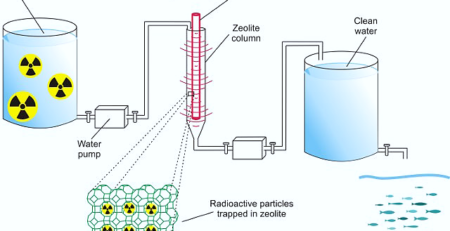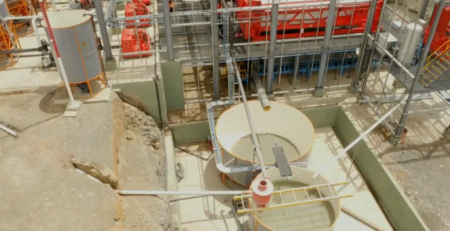Using IoT and Artificial Intelligence to Detect, Manage, and Control H₂S in Crude Oil and Gas Exploration
Using IoT and Artificial Intelligence to Detect, Manage, and Control H₂S in Crude Oil and Gas Exploration
⚠️ 1. Understanding H₂S and Its Dangers
Hydrogen Sulfide (H₂S) is a highly toxic, corrosive, and flammable gas often found in crude oil and natural gas reservoirs. It is considered a sour gas and poses multiple risks:
| Risk Type | Impact |
| Health Hazard | H₂S is lethal even at low concentrations (as low as 100 ppm). |
| Corrosion | It reacts with water to form sulfuric acid, causing internal corrosion in pipes and equipment. |
| Operational Downtime | Requires shutdown and evacuation if levels exceed safety thresholds. |
| Environmental and Regulatory Risk | Releases are strictly regulated and monitored. |
🛑 2. Traditional Challenges in H₂S Management
| Challenge | Description |
| Delayed Detection | Manual gas testing leads to slow responses. |
| Non-continuous Monitoring | Spot testing cannot identify transient spikes or leaks. |
| Remote Locations | Many oilfields and wells are unmanned or offshore. |
| Corrosion Prediction | Hard to link H₂S levels with real-time corrosion rates. |
| Complex Fluid Composition | Coexistence with CO₂, water, and other compounds complicates detection and control. |
🛰️ 3. Role of IoT in H₂S Detection and Monitoring
🧪 3.1. Smart Sensors for Real-Time Monitoring
IoT-based H₂S sensors provide continuous, remote monitoring at key points in the production chain.
| Sensor Type | Application |
| Electrochemical H₂S Sensors | Accurate and sensitive to H₂S in ppm/ppb levels. Installed in wellheads, separators, pipelines. |
| Infrared (IR) Gas Detectors | Used in harsh environments, detects H₂S gas clouds. |
| Tunable Diode Laser Absorption Spectroscopy (TDLAS) | Measures H₂S in gas pipelines with high precision. |
| Corrosion Probes (ER & LPR) | Monitor metal loss rate due to H₂S corrosion. |
| Multigas Monitors | Combine H₂S, CO₂, CH₄, and O₂ detection. Ideal for unmanned platforms. |
🔗 3.2. Data Collection and Transmission
IoT devices communicate wirelessly via:
- 4G/5G cellular, LoRaWAN, NB-IoT, or satellite
- Send data to edge gateways or cloud platforms
- Support real-time alerts, trending, and historical logging
🧠 4. Artificial Intelligence in H₂S Management and Control
AI turns raw IoT sensor data into actionable intelligence for predictive and autonomous control.
📈 4.1. Predictive H₂S Mapping
- AI models analyze historical H₂S readings, geology, flowrates, and composition.
- Generate real-time H₂S dispersion models and hotspot prediction across the field.
- Helps optimize:
- Drilling direction (to avoid high-H₂S zones)
- Casing and metallurgy choices
- Safety planning
⚙️ 4.2. Real-Time Anomaly Detection
- Detects abnormal H₂S spikes due to:
- Casing breach
- Reservoir fluid changes
- Leaks or equipment failure
- Alerts triggered for evacuation or shutdown procedures
🧪 4.3. Corrosion and Asset Integrity Management
AI models correlate:
- H₂S levels
- Water cut
- Flow velocity
- pH
- Metal loss rates (from sensors)
To predict future corrosion, allowing proactive maintenance and pipe replacement schedules.
⚗️ 4.4. Dynamic Chemical Dosing
AI can control scavenger dosing systems based on live H₂S data:
- Injects triazine, MEA, or other scavengers proportionally
- Minimizes chemical wastage
- Adjusts dosing to flow rate and temperature in real-time
📊 4.5. Safety & Regulatory Compliance
- AI ensures H₂S levels are always below regulatory thresholds.
- Automates report generation for OSHA, EPA, or local oilfield regulations.
- Integrates with emergency shutdown (ESD) systems.
🧰 5. System Architecture
mermaid
CopyEdit
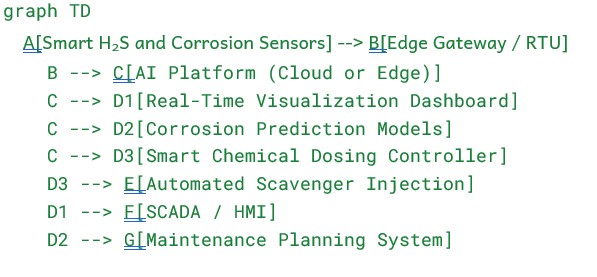
6. Field Application Examples
🛢️ Example 1: Unmanned Onshore Sour Gas Well
- TDLAS gas analyzers monitor H₂S at the wellhead.
- AI predicts H₂S spikes due to formation water intrusion.
- Chemical injection pumps are auto-adjusted based on flow conditions.
- Alerts sent to control room and mobile devices in case of abnormal H₂S levels.
⚓ Example 2: Offshore Platform with Gas-Lift Wells
- IR-based area monitors ensure atmospheric H₂S detection for safety.
- AI distinguishes false positives due to wind or heat distortion.
- System controls both scavenger and corrosion inhibitor dosing via smart algorithms.
✅ 7. Benefits of IoT and AI in H₂S Management
| Benefit | Description |
| 🎯 Accurate Detection | Real-time, continuous H₂S sensing across the facility |
| 🧠 Smart Prediction | AI predicts H₂S levels and corrosion risk ahead of time |
| 🔐 Improved Safety | Early detection allows timely evacuation and system shutdown |
| 💰 Cost Efficiency | Reduces chemical overdosing, unplanned downtime, and maintenance costs |
| 📡 Remote Autonomy | Ideal for unmanned or offshore installations |
| 📄 Regulatory Compliance | AI automates reporting and ensures adherence to safety limits |
🔮 8. Future Developments
- Digital Twin for H₂S Exposure Modeling
Simulates H₂S behavior across facility layout and time series. - AI Co-Pilots for Field Engineers
Wearable AR with live H₂S predictions, safety zones, and sensor overlays. - Robotic Inspection Drones
Equipped with H₂S sensors for pipeline and tank inspections. - Blockchain-Backed Compliance Reporting
Immutable H₂S exposure logs for audits and certifications.
🏁 Conclusion
In sour crude oil and gas exploration, managing H₂S is non-negotiable due to the health, safety, and environmental risks. The integration of IoT and AI transforms traditional reactive approaches into smart, proactive systems that:
- Continuously monitor H₂S
- Accurately predict risks
- Intelligently respond through chemical dosing or safety protocols
- Operate autonomously in unmanned environments
“With IoT as the sensory system and AI as the decision-maker, oil and gas fields can manage H₂S smarter, safer, and faster than ever before.”


